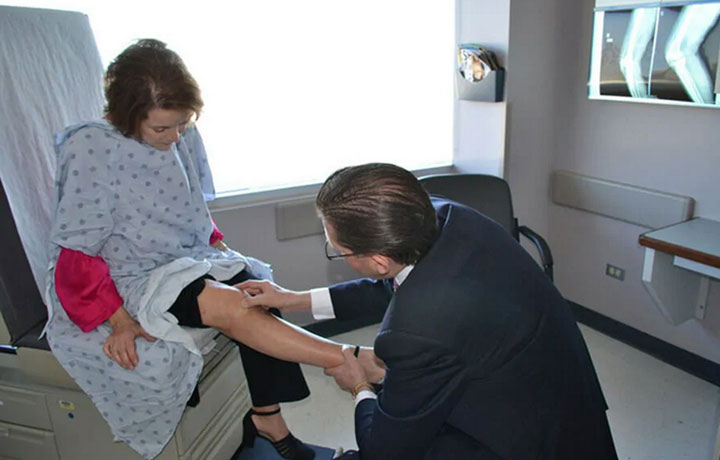After knee replacement at another hospital in 2011, Gloria Leischner, 70, grew increasingly depressed. Instead of giving her a new lease on life, her new knees caused extreme pain and stiffness. She had difficulty walking, navigating stairs, and couldn’t sit in a chair with her legs bent.

In March, she told The Wall Street Journal, “I thought I was just going to have to live like this.”
That is, until she met Henry Finn, MD, medical director of the Chicago Center for Orthopedics at Weiss and chairman of orthopedic surgery at the hospital. Dr. Finn has treated hundreds of patients who had experienced the same thing as Gloria following knee replacement surgery. Due to an unpredictable buildup of scar tissue, these patients develop heavy scar tissue that can severely disable them.
The condition is called arthrofibrosis. An estimated 6 percent of people who undergo a knee replacement develop it, The Wall Street Journal reports. And with some 720,000 total knee replacements happening every year in the United States, according to the Centers for Disease Control and Prevention, that’s a lot of potentially frustrated patients.
Physical therapy and anti-inflammatory drugs can help people with mild scar tissue, but the next course of action requires anesthesia, as a surgeon works to break up the scar tissue. These procedures don’t always work, though, reports The Wall Street Journal. Sometimes, they result in even more scar tissue.
Dr. Finn’s approach is different. He treats arthrofibrosis by exposing the patient’s knee to low-dose radiation just before surgery to remove the original knee replacement and scar tissue. He then replaces the replacement with a more stabilized implant.
Some surgeons in the field raise concerns over skin and tissue damage to the area from the radiation, but Dr. Finn told The Wall Street Journal that the risk is minimal. Radiation is used to prevent extra bone growth in hip joints, and plastic surgeons use it to prevent scarring.
“It made sense to apply it to the knee, and we found it works well. The radiation essentially prepares the body for another procedure by turning off the scar- and bone-forming cells that come with surgical trauma,” Dr. Finn told The Wall Street Journal.
In a 2013 study in the Journal of Arthoplasty, Dr. Finn reported that the procedure improved range of motion in 13 out of 14 patients.
Gloria has experienced the difference firsthand. Since her repairs in August and January, she told The Wall Street Journal that her range of motion has returned and the pain subsided. She continues to go to physical therapy and said she wants to bike and run with her grandchildren in the coming months.
For more on Dr. Finn’s approach to arthrofibrosis and other unique treatments, check out The Wall Street Journal article. You can alsowatch The Wall Street Journal’s video of the story.
If you’re interested in learning more about Dr. Finn or scheduling an appointment, call (888) 503-ORTHO or request an appointment online.
